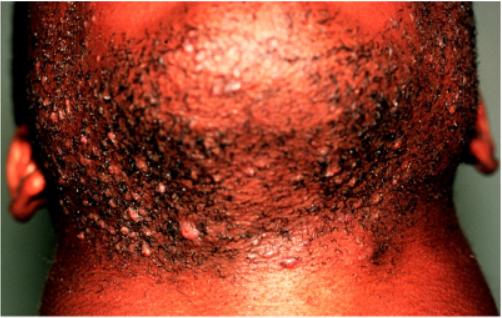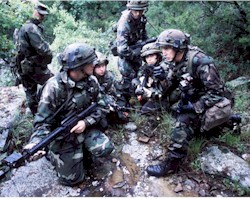|
Pseudofolliculitis Barbae (PFB)
|
Although this is mostly an administrative problem, it is of
importance to the operational primary care provider. The Department
of Defense does not require clean shaven faces merely for the sake of
military appearance. Grooming is important because bearded faces have
greater difficulty in obtaining gas tight seals on a gas mask or
oxygen breathing apparatus. The practice of liberally giving "no
shave chits" besides being unprofessional may actually harm your
patient in certain operational situations. BUPERS instruction 1000.22
and Marine Corps Order 6310.1B outline the current program and
administrative procedures including the phases of therapy and how to
properly use them.
Although some patients
truly must grow short, well-trimmed beards as the only way to control
their PFB, the majority of motivated patients can be helped by simple
measures. Most PFB patients are quite motivated, but need your
interest and guidance. Your attention to this frequently
misunderstood problem will reap great rewards. You will be rewarded
by the respect of your patients and better clinical results.
First of all, make sure
that the patient truly has PFB. Some patients may also have
coexistent acne, which is worsened by the act of shaving. Examine
the skin carefully. Treatment of PFB alone in the presence of
coexisting acne is doomed to failure. Both conditions must be
approached simultaneously.
 Most cases of PFB
require a period of no shaving to give the inflamed hairs a change to
grow out to let the inflammation die down. Mild cases may require
only 2 weeks of "no shave" whereas more severe cases frequently need 4
weeks or longer. Impacted hairs can be delicately dislodged during
this period by gently massaging them (barely touching the face) using
a circular motion with an extra soft toothbrush. Most cases of PFB
require a period of no shaving to give the inflamed hairs a change to
grow out to let the inflammation die down. Mild cases may require
only 2 weeks of "no shave" whereas more severe cases frequently need 4
weeks or longer. Impacted hairs can be delicately dislodged during
this period by gently massaging them (barely touching the face) using
a circular motion with an extra soft toothbrush.
Once grooming is
resumed, remember that the goal is to have some "stubble" remain on
the problematic areas. This is done by "shaving with the grain",
whether one is using a PFB razor, electric razor, beard clipper, or
removing with a chemical depilatory. Going "against the grain"
defeats the whole strategy of leaving "stubble" because the hairs
would be cut shorter. The act of hair removal is more physically
irritating to the skin.
Chemical depilitory products can play a role in some, but not all
patients. Several patients prefer to use these products despite an
unpleasant smell during their use. The most widely available of
several commercial products is Magic Shave. The instructions on the
container need to be explicitly followed or else an irritant
dermatitis will almost always occur. Even if properly used, many
patients develop a mild tightness and chapping of the face and neck.
Be careful.
Written and revised by CAPT Dennis
A. Vidmar, MC, USN, Department of Military and Emergency
Medicine, and Department of Dermatology, Uniformed Services University
of the Health Sciences, Bethesda, MD (1999).
Additional images provided by CAPT Vidmar in
June, 2000, subsequent to the initial publication of this manual.
|
Preface
· Administrative Section
· Clinical Section
The
General Medical Officer Manual , NAVMEDPUB 5134, January 1, 2000
Bureau
of Medicine and Surgery, Department of the Navy, 2300 E Street NW, Washington, D.C.,
20372-5300
This
web version of The General Medical Officer Manual, NAVMEDPUB 5134 is provided by
The Brookside Associates
Medical Education Division. It contains original contents from the
official US Navy version, but has been reformatted for web access and
includes advertising and links that were not present in the original version.
This web version has not been approved by the Department of the Navy or the
Department of Defense. The presence of any advertising on these pages does not
constitute an endorsement of that product or service by either the Department of
Defense or the Brookside Associates. The Brookside Associates is a private
organization, not affiliated with the United States Department of Defense. All
material in this version is unclassified. This formatting © 2006
Medical Education Division,
Brookside Associates, Ltd.
All rights reserved.
Home
·
Textbooks and Manuals
·
Videos
·
Lectures
·
Distance Learning
·
Training
·
Operational Safety
·
Search
This website is dedicated to the development and dissemination of medical information that may be useful to those who practice Operational Medicine. This website is privately-held and not connected to any governmental agency. The views expressed here are those of the authors, and unless otherwise noted, do not necessarily reflect the views of
the Brookside Associates, Ltd., any governmental or private organizations. All writings, discussions, and publications on this website are unclassified.
© 2006 Medical Education Division, Brookside Associates, Ltd. All rights reserved
Other Brookside Products
Contact Us

|
|

